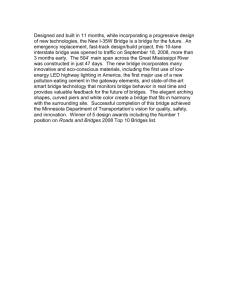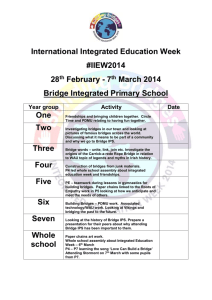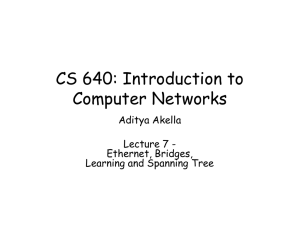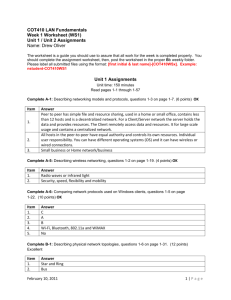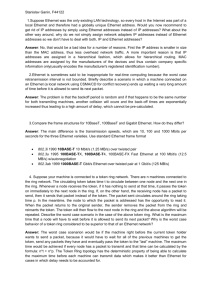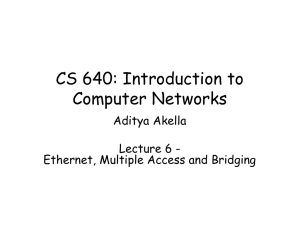SUBJECT CODE: CS6551 SUBJECT NAME: COMPUTER
advertisement
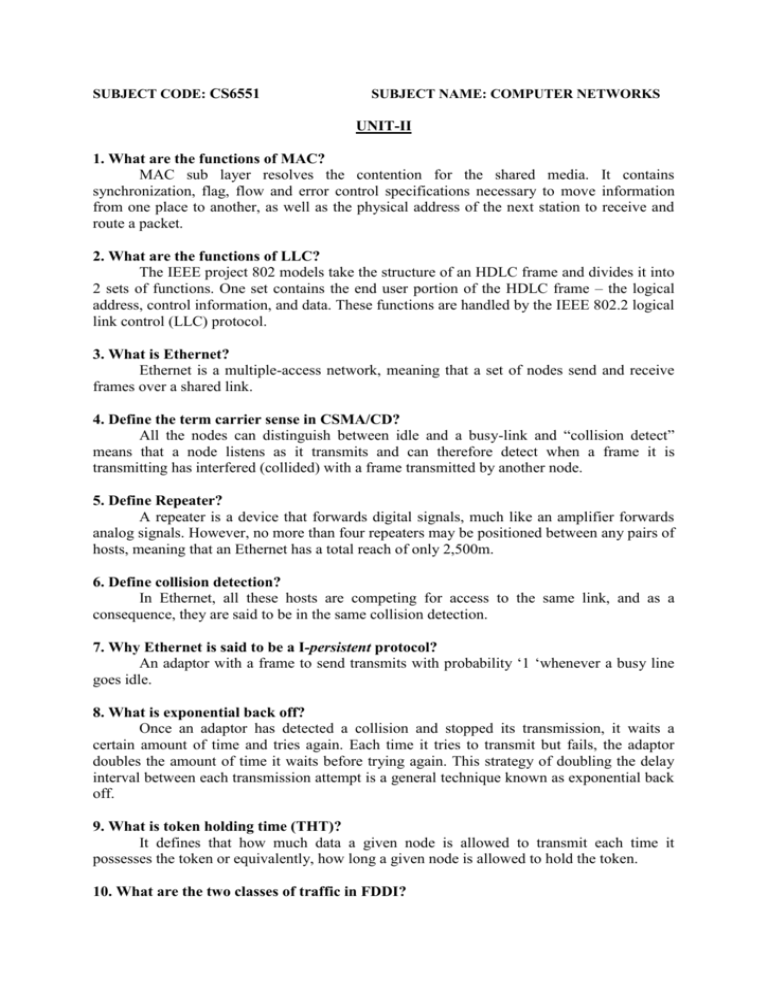
SUBJECT CODE: CS6551 SUBJECT NAME: COMPUTER NETWORKS UNIT-II 1. What are the functions of MAC? MAC sub layer resolves the contention for the shared media. It contains synchronization, flag, flow and error control specifications necessary to move information from one place to another, as well as the physical address of the next station to receive and route a packet. 2. What are the functions of LLC? The IEEE project 802 models take the structure of an HDLC frame and divides it into 2 sets of functions. One set contains the end user portion of the HDLC frame – the logical address, control information, and data. These functions are handled by the IEEE 802.2 logical link control (LLC) protocol. 3. What is Ethernet? Ethernet is a multiple-access network, meaning that a set of nodes send and receive frames over a shared link. 4. Define the term carrier sense in CSMA/CD? All the nodes can distinguish between idle and a busy-link and “collision detect” means that a node listens as it transmits and can therefore detect when a frame it is transmitting has interfered (collided) with a frame transmitted by another node. 5. Define Repeater? A repeater is a device that forwards digital signals, much like an amplifier forwards analog signals. However, no more than four repeaters may be positioned between any pairs of hosts, meaning that an Ethernet has a total reach of only 2,500m. 6. Define collision detection? In Ethernet, all these hosts are competing for access to the same link, and as a consequence, they are said to be in the same collision detection. 7. Why Ethernet is said to be a I-persistent protocol? An adaptor with a frame to send transmits with probability ‘1 ‘whenever a busy line goes idle. 8. What is exponential back off? Once an adaptor has detected a collision and stopped its transmission, it waits a certain amount of time and tries again. Each time it tries to transmit but fails, the adaptor doubles the amount of time it waits before trying again. This strategy of doubling the delay interval between each transmission attempt is a general technique known as exponential back off. 9. What is token holding time (THT)? It defines that how much data a given node is allowed to transmit each time it possesses the token or equivalently, how long a given node is allowed to hold the token. 10. What are the two classes of traffic in FDDI? Synchronous Asynchronous 11. What are the four prominent wireless technologies? Bluetooth Wi-Fi(formally known as 802.11) WiMAX(802.16) Third generation or 3G cellular wireless. 12. Define Bluetooth? Bluetooth fills the niche of very short-range communication between mobile phones, PDAs, notebook computers, and other personal or peripheral devices. For example, Bluetooth can be used to connect mobile phones to a headset, or a notebook computer to a printer. 13. What are the four steps involves in scanning? 1. The node sends a Probe frame. 2. All APs within reach reply with a Probe Response frame. 3. The node selects one of the access points, and sends that AP an Association Request frame. 4. The AP replies with an Association Response frame. 14. Explain the term handoff? If the phone is involved in a call at the time , the call must be transferred to the new base station in what is called a hand off. 15. Define satphones? Satphones use communication satellites as base stations, communicating on frequency bands that have been reserved internationally for satellite use. 16. How to mediate access to a shared link? Ethernet,token ring, and several wireless protocols. Ethernet and token ring media access protocols have no central arbitrator of access. Media access in wireless networks is made more complicated by the fact that some nodes may be hidden from each other due to range limitations of radio transmission. 17. Define Aggregation points? It collects and processes the data they receive from neighboring nodes, and then transmit the processed data. By processing the data incrementally, instead of forwarding all the raw data to the base station, the amount of traffic in the network is reduced. 18. Define Beacons? Beacon to determine their own absolute locations based on GPS or manual configuration. The majority of nodes can then derive their absolute location by combining an estimate of their position relative to the beacons with the absolute location information provided by the beacons. 19. What is the use of Switch? It is used to forward the packets between shared media LANs such as Ethernet. Such switches are sometimes known by the obvious name of LAN switches. 20. Explain Bridge? It is a collection of LANs connected by one or more bridges is usually said to form an extended LAN. In their simplest variants, bridges simply accept LAN frames on their inputs and forward them out on all other outputs. 21. What is Spanning tree? It is for the bridges to select the ports over which they will forward frames. 22. What are the three pieces of information in the configuration messages? 1. The ID for the bridge that is sending the message. 2. The ID for what the sending bridge believes to the root bridge. 3. The distance, measured in hops, from the sending bridge to the root bridge. 23. What is broadcast? Broadcast is simple – each bridge forwards a frame with a destination broadcast address out on each active (selected) port other than the one on which the frame was received. 24. What is multicast? It can be implemented with each host deciding for itself whether or not to accept the message. 25. How does a given bridge learn whether it should forward a multicast frame over a given port? It learns exactly the same way that a bridge learns whether it should forward a unicast frame over a particular port- by observing the source addresses that it receives over that port. 26. What are the limitations of bridges? scale heterogeneity


